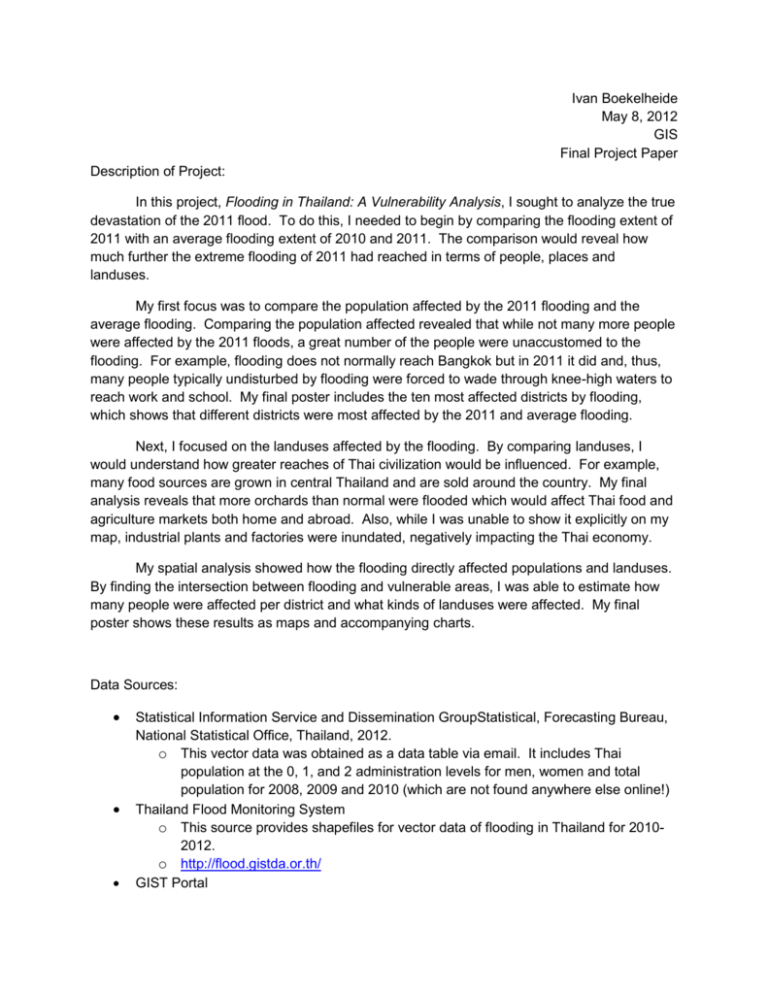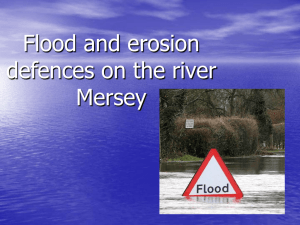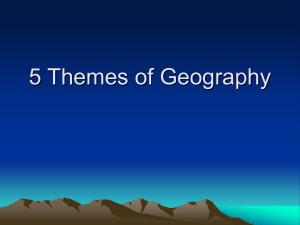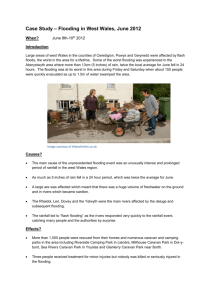Final_Paper_Thai_Flooding
advertisement

Ivan Boekelheide May 8, 2012 GIS Final Project Paper Description of Project: In this project, Flooding in Thailand: A Vulnerability Analysis, I sought to analyze the true devastation of the 2011 flood. To do this, I needed to begin by comparing the flooding extent of 2011 with an average flooding extent of 2010 and 2011. The comparison would reveal how much further the extreme flooding of 2011 had reached in terms of people, places and landuses. My first focus was to compare the population affected by the 2011 flooding and the average flooding. Comparing the population affected revealed that while not many more people were affected by the 2011 floods, a great number of the people were unaccustomed to the flooding. For example, flooding does not normally reach Bangkok but in 2011 it did and, thus, many people typically undisturbed by flooding were forced to wade through knee-high waters to reach work and school. My final poster includes the ten most affected districts by flooding, which shows that different districts were most affected by the 2011 and average flooding. Next, I focused on the landuses affected by the flooding. By comparing landuses, I would understand how greater reaches of Thai civilization would be influenced. For example, many food sources are grown in central Thailand and are sold around the country. My final analysis reveals that more orchards than normal were flooded which would affect Thai food and agriculture markets both home and abroad. Also, while I was unable to show it explicitly on my map, industrial plants and factories were inundated, negatively impacting the Thai economy. My spatial analysis showed how the flooding directly affected populations and landuses. By finding the intersection between flooding and vulnerable areas, I was able to estimate how many people were affected per district and what kinds of landuses were affected. My final poster shows these results as maps and accompanying charts. Data Sources: Statistical Information Service and Dissemination GroupStatistical, Forecasting Bureau, National Statistical Office, Thailand, 2012. o This vector data was obtained as a data table via email. It includes Thai population at the 0, 1, and 2 administration levels for men, women and total population for 2008, 2009 and 2010 (which are not found anywhere else online!) Thailand Flood Monitoring System o This source provides shapefiles for vector data of flooding in Thailand for 20102012. o http://flood.gistda.or.th/ GIST Portal o This site provided the administration boundary shapefiles from 2000 as well as the landuse shapefiles from 2000. This site also had a variety of other shape files including hydrography, roads, utilities and other rivers and streams. o The data I used is all vector. o The source for this data is United Nations Economic and Social Commission for Asia and the Pacific (UNESCAP) o https://gistdata.itos.uga.edu/portal?page=1&title_op=contains&title=thailand&field _abstract_value_op=contains&Abstract=&sort_by=title&sort_order=ASC&items_ per_page=20 Major Steps in Data Preparation and Analysis (Note on maps included: sources and legends are found on the poster): Data Preparation (After downloading and receiving all the data I would use): The only data set I needed to prepare was the district census level data because it arrived in an excel file via email. I cleaned the data so I was left with only district names and accompanying population data. I was then able to bring this data into ArcMap where I would eventually join it to the district level layer in order to map population by district. Comparing 2011 Flooding with Average Flooding: The first step was to merge all the flooding shapefiles for the 2011 flooding. After many struggles due to large files, I successfully dissolved all the layers into a single flood extent layer by converting to raster and back. Next I did the same for the 2010 flooding. I then intersected the 2011 and 2010 layers to create a single layer that would represent the average flooding. Finally I mapped the 2011 flooding extent against the 2010 to compare the difference in extent. I then mapped the average flooding in a separate map in order to compare all three. The result: Analyzing Population Affected By Flooding: I began by intersecting the district level layer with the district census information. I intersected the resulting layer with my flooding layer to show where all districts and flooding intersected. Separately, I used the field calculator in the attribute table to create data that showed the percent of population affected by flooding in each district. I then joined my layer representing the fragmented population affected by flooding with the extent of the flooding. The result was my final layer which could be used to show a gradient of populations by district that were affected by flooding. I went through this process for both the 2011 flooding and the average flooding. My poster also includes a chart identifying the top-ten most affected districts by population. The results are below: Analyzing Landuses Affected By Flooding: I intersected landuses with my newly created flooding extent layer. The resulting layer showed what kinds of areas were affected by flooding. I took this information and put it into excel in order to create pie charts which show kinds of landuses affected as a percentage of the total landuses affected. Here are my maps: Landuses Affected By 2011 Flooding 2%1% 2% 4% 5% Mixed orchards 83 % 2% 4% Paddy field Sugar cane Field crops Marsh Average Landuses Affected (2010-11) 1% 4%2% 87 % Paddy field Marsh Sugar cane Field crops Mixed orchards Difficulties Encountered, etc. Never dissolve large files! I thought dissolving would be a relatively simple process but it turned out that dissolving my 22 layers of flooding shapefiles took forever. I resolved the problem by turning the layers from vector to raster and reconverting. I ended up with a vector layer that worked throughout the rest of my analysis. Cleaning up the census data I received from the Thai National Statistics Office was a challenge because the district layer I downloaded from GIST Portal had slightly different Thai and English names than the census data. As I result, I had to go through the data to create a common ID number in order to join the two types of data. The last major impediment I encountered happened just when I thought I was finished. For some reason I still don’t understand, my maps showing population affected stopped including all the districts that were intersecting the flooding extents. Instead, a random set of districts were displayed. As a result, I had to go back and redo all steps to recreate the necessary layers for the maps. Conclusions on Approach: There is a central flaw to my approach, I can only show estimates of population affected. This is because my data is limited to a district level (albeit much better than the province level I thought I was going to have to use). So, I used the percentage of the district intersected with flooding as the same percentage of people affected out of the total district population. While this gives a general picture of the population affected, it lacks accuracy. For example, districts where rice paddies were predominantly affected register as having higher amounts of affected people than is likely the case. The other limit on my project (like the projects of many others) was data. Ideally, I would like to have shown an economic picture of the impact of flooding. However, the best data I had to use was landuses. Using landuses was an interesting way to think about the impact of flooding but did not provide hard, exact data. In general, my approach was not too complicated but provided an illustration of the extent of the 2011 flooding. By considering populations and landuses, the major vulnerabilities to flooding were exposed. While the Thai government probably should not use my work as a guide for prevention methods, my project provides a glimpse into the effects of a very recent and large-scale natural disaster. Articles Considered: 1) Lebel, Louis; Jesse Manuta; Po Garden, “Institutional traps and vulnerability to changes in climate and flood regimes in Thailand,” Regional Environmental Change, Vol. 11, Issue 2 (3/1/2011) http://www.springerlink.com/content/n40234346vt15273/export-citation/ This article examines how flood responses can be more effectively managed. The article offers ideas for the shortcomings in the Thai response to the 2011 flood and how that made the problem worse. The focus is on social factors that affected flood plains and other natural areas for water run-off. The ideas presented in this article are more complicated than my analysis. However, my work provides a great starting point for incorporating more sophisticated methods of analysis. 2) Kuntiyawichai, K., Schultz, B., Uhlenbrook, S., Suryadi, F. X. and Van Griensven, A. (2011), “Comparison of flood management options for the Yang River Basin, Thailand.” Irrigation and Drainage, 60: 526–543. doi: 10.1002/ird.596 This article examines the Yang River Basin in Northeast Thailand to consider ideas for dealing with flooding. The article uses GIS technique and Thai government data to layer maps that describe flooding problems. Although the location in Thailand is slightly different than my focus, this article is a great source for technique on how to think about and address the issue of flooding in Thailand. The articles shares similarities to my project in terms of assessing flood extent. I did not use any part of it directly for my project. 3) Sanyal, J. and Lu, X. X. (2005), “Remote sensing and GIS-based flood vulnerability assessment of human settlements: a case study of Gangetic West Bengal, India.” Hydrol. Process., 19: 3699–3716. doi: 10.1002/hyp.5852 (http://onlinelibrary.wiley.com/doi/10.1002/hyp.5852/abstract) This article uses Gangetic West Bengal as a case study for rural settlement vulnerabilities to seasonal flooding. The study uses satellite imagery and spatial analysis to show vulnerable areas. While this region is home to smaller communities than found in Thailand, the process of examining rural vulnerabilities is germane to my project. I believe this study provides insight into using spatial analysis to map areas vulnerable to flooding. I used the same idea technique of satellite imagery with spatial analysis to form my project. The flood layers I used all came from satellite imagery. 4) Wang, Yamei; Zhongwu Li; Zhenghong Tang and Guangming Zeng (2011), “A GISBased Spatial Multi-Criteria Approach for Flood Risk Assessment in the Dongting Lake Region, Hunan, Central China.” Water Resources Management. Volume 25, Number 13, 3465-3484, DOI: 10.1007/s11269-011-9866-2 (http://www.springerlink.com/content/66061713l1880820/abstract/) This study offers another example of using GIS spatial analysis for flood risk assessment. Here, the focus is China. I plan to consider the methods used in this article for my project. I especially like how the authors have categorized different degrees of risk. I hope to use a similar scale to show which parts of Thailand are more vulnerable to flooding. I was unable to use different degrees of risk in my project. Perhaps, with much more time and data, I would be able to do such a thing. It is a very interesting idea which would make my project better.








